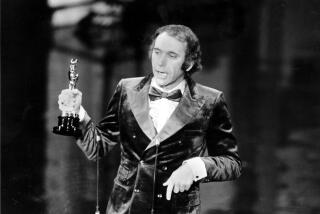Refugees and free speech: How Hollywood classics ‘Casablanca’ and ‘High Noon’ were shaped by politics
- Share via
What does it mean to be a moral person? Faced with adversity, would we choose to do the right thing? These fundamental questions are at the heart of two of Hollywood’s most iconic films —“Casablanca” and “High Noon”— and contribute to their timeless appeal. To coincide with “Casablanca’s” 75th and “High Noon’s” 65th anniversaries, two new books explore how this preoccupation with questions of conscience arose in response to historical circumstances: the Hollywood blacklist in the case of “High Noon” and World War II and the refugee crisis it created for “Casablanca.”
In “We’ll Always Have Casablanca,” Noah Isenberg dives into the film’s production history, calling attention to the extensive contributions of exiles from Hitler’s Europe. In “High Noon,” Glenn Frankel examines the movie’s production against the intense Cold War politics that shaped its message. Both accounts resonate with our current political moment and urgent debates concerning refugees, fascism and the protection of civil and constitutional rights.
From its inception, “Casablanca” was informed by the European turmoil that would erupt into WWII. Murray Burnett, the high school English teacher who — with co-author Joan Alison — wrote the play “Everybody Comes to Rick’s” that provided the film’s source material, traveled to Europe in summer 1938. To assist relatives, he and his wife smuggled jewels and other assets out of Nazi Germany-controlled Austria. The young couple then arrived in the South of France, where they spent an evening at a nightclub whose cosmopolitan clientele provided the inspiration for Rick’s café. During his time in Europe, Burnett also learned of the refugee trail from Marseille to Morocco to Lisbon that found its way into “Casablanca.”
These books resonate with our current political moment and urgent debates concerning refugees, fascism and the protection of civil and constitutional rights.
A copy of “Everybody Comes to Rick’s” arrived on the desk of Warner Bros. producer Hal B. Wallis on Dec. 8, 1941, the morning after the attack on Pearl Harbor. Wallis saw its potential and bought the rights for $20,000, an unprecedented amount for an unproduced play. In casting the picture, Warner’s drew from the 1,500 German and Austrian film professionals who had resettled in Hollywood by the early 1940s. Most of the 75-member cast were immigrants, many with first-hand knowledge of Europe’s refugee crisis and the experience of exile. Isenberg cites numerous examples from the movie’s production to make his case for the importance of the refugee theme to “Casablanca.” For instance, director Michael Curtiz, desperate to help relatives trapped in Hungary, asked his screenwriters to insert vignettes highlighting the plight of refugees.
Although there were limits to “Casablanca”’s efforts to humanize Europe’s refugees (Isenberg pointedly notes, quoting novelist André Aciman, the “structural absence of the Jewish question”), its sympathetic gaze, along with Rick’s evolution from isolation to engagement, shored up support for the war effort among American audiences (at least judging by the film’s huge box office success). “Casablanca’s” politics were also in keeping with Warner Bros. President Harry Warner’s ardent anti-fascism; Warner’s had become the first Hollywood studio to address the threat of National Socialism three years earlier with “Confessions of a Nazi Spy.”
As recent events have shown, political movements can turn on a dime (or an election), and the anti-fascist stance that recommended “Casablanca” to America’s wartime audiences quickly became suspect in the immediate postwar years. In “High Noon,” Frankel discusses the film’s creation against the backdrop of the “tectonic shifts in American politics and culture” that occurred during the Truman and Eisenhower administrations. In November 1946, Republicans won control of both houses of Congress for the first time in almost two decades and quickly set about dismantling Franklin D. Roosevelt’s progressive coalition. Conservative opponents of the New Deal, working-class populists and self-styled Americanists convinced that “outsiders” (read: liberals, Jews and Communists) posed a threat to America’s security and values now had a legislative voice. As Frankel puts it, “[t]he backlash now had official sanction from Washington.”
The House Un-American Activities Committee, established in 1938, recognized that its time had come and launched its first round of investigations into Communist activity in Hollywood in October 1947. Frankel reviews the now familiar history of the blacklist with grace and accuracy; his descriptions of witness testimony are particularly vivid. Carl Foreman, “High Noon’s” screenwriter and — with Gary Cooper — the hero of Frankel’s narrative, was not called to testify in 1947; as he put it, he was too insignificant for the committee to bother with back then. However, that had changed by the time “High Noon” began preproduction in summer 1951. By then, Foreman had been nominated for Academy Awards for his screenplays for “Champion” (1949) and “The Men” (1950). Both films were the result of his ultimately troubled partnership with Stanley Kramer, a pioneering independent producer (and later director, not least on “Judgment at Nuremberg”).
Foreman received his subpoena from HUAC on June 13, 1951, while he was finishing the script to “High Noon.” His original idea for the story of a town under siege by outside forces, intended as a paean to the United Nations, had already morphed into something far darker and less hopeful: the story of the death of Hollywood. With the studios denying employment to past or suspected Communists and Communist sympathizers, Hollywood’s progressive community had shattered. Old friends avoided each other, phones were tapped, betrayals abounded. As Frankel writes, the “gathering sense of dread became the emotional core of Carl’s story”; Foreman found himself transposing dialogue straight from his life into the script.
Although he would later insist that “High Noon” was an allegory for the blacklist, it was not viewed as such by others involved in the film. Director Fred Zinnemann saw Marshal Will Kane’s lonely struggle as the story of conscience versus compromise. The casting of Cooper as Kane also ensured that this struggle would be viewed by audiences as valiant, moral and deeply American, all values Cooper’s star persona projected. The star’s politics were conservative but not dogmatic, and he emerges from Frankel’s account as much a man of principle as the character he portrays. If Cooper’s Will Kane “confirm[ed] our self-portrait as a moral and honorable nation,” “High Noon’s” ideological flexibility made it a favorite with American presidents on both sides of the aisle (Dwight Eisenhower screened the film at least three times, while Bill Clinton topped the list with 20 viewings).
“We’ll Always Have Casablanca” and “High Noon” are fascinating reads, packed with fun trivia (Ronald Reagan was considered for the role of Rick! Foreman almost succumbed to a drunken tryst with Red-baiting gossip columnist Hedda Hopper!), but they are also profoundly relevant in their explorations of how our politics and creative industries not only hold a mirror to each other but also to the nation.
Prime is a film historian and the author of “Hollywood Exiles in Europe: The Blacklist and Cold War Film Culture.”
“We’ll Always Have Casablanca: The Life, Legend, and Afterlife of Hollywood’s Most Beloved Movie”
Noah Isenberg
W.W. Norton: 336 pp., $27.95
::
“High Noon: The Hollywood Blacklist and the Making of an American Classic”
Glenn Frankel
Bloomsbury: 400 pp., $28
More to Read
Sign up for our Book Club newsletter
Get the latest news, events and more from the Los Angeles Times Book Club, and help us get L.A. reading and talking.
You may occasionally receive promotional content from the Los Angeles Times.






